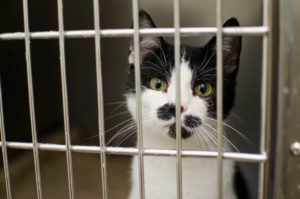Community Cats Need Our Help
Community cats are at risk. They're at risk of being unwanted, ignored, of being considered nothing more than "pests." With an estimated 200,000 of these cats in the Las Vegas area, and with limited resources to support services and programming, this critical animal welfare problem won't be an easy one to tackle. For so many reasons, however, we need to start opening up conversations about working together to help community cats.
Whether you're a rescue & adoption advocate, a colony caretaker, or just a concerned citizen who has noticed some cats in your neighborhood, you can be a part of the solution.
The Life of a Community Cat
When we talk about “community cats,” we’re talking about outdoor, free-roaming cats. They may be socialized or feral, old or young, sterilized or intact. One important characteristic of all community cats is that they do not have an owner, although some may live in colonies with caretakers who feed and spay/neuter these cats.
Especially without a designated caretaker, community cats face a life filled with challenges.
- Hunger - Many go without enough food because they simply don’t have the luxury of a caring pet parent.
- Illness - Unvaccinated, they’re prone to many easily preventable diseases. Unspayed and unneutered, they’re more susceptible to certain types of cancers and infections.
- Injury - The life of an outdoor cat is filled with the threat of injury from predators, vehicles, and unfortunately even people.
- Uncontrolled population growth - When community cats remain unspayed and unneutered, they can reproduce incredibly quickly, especially in an environment like Las Vegas with a warm climate & long breeding season. An unspayed female, with an average litter of 4 kittens, can produce 2 or even 3 litters during a Las Vegas breeding season - that’s 8-12 kittens per female per year. That adds up fast, and increases the burden on already limited resources meant to feed, sterilize, and care for these cats. The most devastating thing? Kitten mortality rates are staggeringly high - as high as 75%, which means there’s a good chance that a kitten born to a community cat will suffer.
The Scope of the Problem
Because of the nature of this population - they’re outdoors, come and go as they please, and are subject to all sorts of accidents and misfortune - it’s hard to say exactly how many community cats live in Las Vegas. In some jurisdictions it’s not permitted to feed or Trap-Neuter-Return these cats, making it even more difficult to get a sense of the population. Our best estimates place the current cat population in the Las Vegas metro area at 200,000.
To put this into context, with 240,000 households in the Las Vegas area, there are about 110,000 indoor house cats in our community. There are almost twice as many free roaming community cats as there are indoor house cats in Las Vegas.
In a nutshell: There are a ton of community cats here in Las Vegas. With limited resources available to them, many suffer from hunger, illness, and injury. Without intervention, they reproduce extremely quickly. Many of the kittens born to community cats will die before their first birthday. Our community cats deserve better.
If You Care About Rescue - and Euthanasia - You Should Care About Community Cats

If you’ve ever met a community cat, chances are she was less than friendly. Although some are totally comfortable around humans, especially if they’re living in a colony with an established caretaker, many are feral, unhandleable, and VERY unsuitable candidates for adoption as they’re frightened of people.
So if you’re passionate about saving adoptable cats, why should you care about serving the community cat population?
Well, there’s a noticeable - and disturbing - euthanasia gap in our country’s rescues and shelters. Each year, of the 920,000 euthanasias performed in shelters, 530,000 of them are cats - that’s about 58% of all euthanasias.
The likely source of most of the cats & kittens that end up in shelters? The community cat population, of course. There are too many of them, reproducing too quickly, for even the most mature rescue & shelter communities to comfortably handle during “kitten season”. Every spring and summer in Las Vegas, we see an absolute onslaught of kittens from community cats needing foster homes, bottle feeding, medical care, and forever families. The supply of kittens outweighs the available resources. When too many cats & kittens overwhelm our rescue and shelter partners, higher euthanasia rates are the inevitable result.
If, as a community, we can better manage our community cat population, we’ll be in a better position to help the cats and kittens in need of adoption - meaning we will not need to euthanize for lack of space, time, or resources. Isn’t that the ultimate goal?
The Best Way to Make a Difference for Community Cats
There are a few ways communities can choose to address community cat populations:
- Do nothing. Some communities, via local ordinances or simply a lack of investment in resources, will ignore community cat populations. From what we’ve seen, this leads to unnecessary suffering as well as an incredible burden on our local shelters & rescues.
- Mass euthanize community cats. Some jurisdictions - fortunately none here in Las Vegas - will address the issue of community cat suffering and overpopulation by trapping & euthanizing. We do not believe this is a humane solution, nor do we believe it is an effective one.
- Invest in Trap-Neuter-Return programming. Trap-Neuter-Return (TNR) is a method of serving community cats that helps both the individual animal and the community cat population as a whole. Cats are brought to a high-quality clinic (like Heaven Can Wait) where they receive lifesaving spay, neuter, and vaccination services. It improves cats’ lives and stabilizes cat populations when other methods fail.
Since Heaven Can Wait was founded in 2000, we’ve provided the highest quality spay & neuter services to over 160,000 Las Vegas cats and dogs - and many of our patients were community cats. Since then, we’ve seen euthanasia rates drop in our local shelter from a high of about 30,000 per year in 2009 to about 1,800 per year in 2020. Spay & neuter efforts work, ESPECIALLY for community cats.
What You Personally Can Do to Save Cats’ Lives
If you’re motivated to help cats in need, it’s hard to know where to start. Here’s what you can do right now to make a difference for cats in your neighborhood:
- Become a colony caretaker. Feeding community cat colonies, as well as ensuring cats are spayed & neutered, is one of the most hands-on (and effective) things you can do right in your neighborhood. There’s no shortage of cats in need! Check out local social media pages to look for caretaker communities and TNR resources, like “Las Vegas Cats” on Facebook. Some of our partner organizations that support TNR include The Animal Foundation, C5, and Las Vegas Valley Humane Society.
- Advocate for progressive community cat ordinances and policies in your community. Reach out to local legislators to find out if (1) local ordinances allow for the care and feeding of community cats (2) if they support TNR initiatives and (3) what resources are allocated to support TNR in your neighborhood. The more legislators believe their constituents care about community cats, the more they’ll care - and start making positive changes.
- Support the Community Cat Action Fund. One of the biggest issues facing community cats, at least here in Las Vegas, is the lack of resources dedicated to serving them. That’s why we’re launching the Community Cat Action Fund. Every dollar donated to the Community Cat Action Fund will directly support spay, neuter, vaccination, and medical services for community cats in need.

Click Here to Make a Donation Today
-
- Here’s what your gift to this fund can do:
-
- $60 supports a spay or neuter surgery, plus lifesaving vaccinations
- $100 supports a spay or neuter surgery, lifesaving vaccinations, and additional medical care for minor medical issues such as ear mites or infection
- $250 can cover a lifesaving surgery for a cat suffering severe trauma or illness, such as a tail amputation or eye removal
- $500 can provide spay, neuter, and vaccination services to an entire colony of community cats
-
However you decide to support community cat initiatives, we know that the best way to help this vulnerable population is together. Educating friends and family about the importance of spay & neuter, TNR, and adoption & rescue is a great place to start.
And of course, if you ever have questions or need assistance connecting with resources, Heaven Can Wait is here to help! Contact us at 702-655-4800 or info@hcws.org.